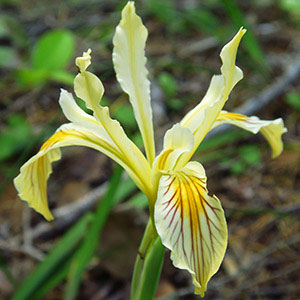Iris bracteata
Iris pumila
Siskiyou iris
dwarf iris
sheathed with old leaf bases, slender, 0.6–0.9 cm diam.;
roots few, fibrous.
freely branching, producing dense clumps, 1–1.5 cm diam.
simple, solid, 1.5–3 dm.
absent or not more than 1 cm.
basal with abaxial surface of blades deep glossy green on one side of fan, light yellow-green on other side, pink or red-tinged basally, strongly ribbed, 4–6 dm × 0.8–1 cm, rigid, margins not thickened;
cauline 3–6, imbricated, closely sheathing stem ca. 2/3 length, spreading distally, bractlike, blade inflated, often shorter than basal leaves.
ascending-spreading;
blade grayish green, ensiform or slightly falcate, 8–10 cm × 6–15 mm at anthesis, increasing to 15–20 cm in length on innovations after flowering, dying back in autumn, new growth only in spring, glaucous.
simple, units 1–2-flowered;
spathes closed tightly around pedicel and ovary, lanceolate, 5.2–9 cm × 6–8 mm, subequal, herbaceous, margins scarious, apex acuminate.
1-flowered, sessile in spathes;
spathes 5–10 cm;
outer darker green than inner, inner closely shielding floral tube.
perianth cream to buff-yellow;
floral tube 0.8–0.9 cm;
sepals with deeper yellow signal, veined with purple or brown, obovate-lanceolate, 6.5 × 2.5 cm, base gradually attenuate into wide claw;
petals narrowly oblanceolate, 7–9 × 0.8–2 cm, base gradually attenuate;
ovary nearly circular in cross section, 1.5–2.5 cm, base gradually attenuate into pedicel, apex abruptly acuminate into floral tube;
style 2.2–3 cm, crests spreading, yellow, not veined, 1.2 × 0.9–1.7 cm, margins toothed;
stigmas triangular or tongue-shaped, margins entire;
pedicel 3–6.2 cm.
floral tube with 3 purple stripes in line with midrib of petals, slender, 6–10 cm × 2–3 mm, lifting expanded portion of flower out of spathes;
sepals yellow, blue, or purple, with yellowish or bluish beard, often with contrasting spot around beard at base of limb, 4–5 × 1.2–2 cm;
petals with darker veins near base, rounded-ovate, broader than sepals, 4–5 × 2.2–2.7 cm, narrowing abruptly to brown-veined claw, apex emarginate;
ovary rounded-trigonal, ca. 1 cm × 4–5 mm;
style crests triangular, margins serrate distally;
stigmas rounded on distal margin, margins entire;
pedicel absent.
nearly circular in cross section, tapering abruptly at each end, 2–2.5 × 1–1.5 cm.
borne on tips of rhizomes at ground level or slightly below, rounded-trigonal, with short portion of dried floral tube forming tip, smooth, 2–3.5 × 1.5–2 cm, dehiscing while green.
dark brown, irregular in shape, wrinkled.
usually in 2 rows per locule, light brown, subspherical, 3–5 mm diam., wrinkled.
= 40.
= 30, 31, 32, 36.
Iris bracteata
Iris pumila
Iris bracteata is limited to one county each in northern California and southern Oregon. It hybridizes with I. chrysophylla, I. douglasiana, I. innominata, I. munzii, I. purdyi, and I. tenax.
(Discussion copyrighted by Flora of North America; reprinted with permission.)
Iris pumila has been shown to be a natural amphidiploid hybrid between I. pseudopumila Boissier & Heldreich and I. attica Tineo, both 2n = 16. Like many other such hybrids, its range of variability is so extensive that many of its forms have been given specific names. In spite of the variability in color and size, it is now recognized as a distinct species. During the past 50 years, it has been crossed repeatedly with several other species, including I. germanica and its mixed progeny, and this has introduced patterns from the tall-bearded iris into the dwarfs, and vice versa. The ranges of flowering season and plant height are now almost continuous from one extreme to the other, and intermediate groups are now recognized.
Iris pumila is widely grown in gardens and often persists for years after cultivation around old dwellings and along roadsides. It is thus extremely difficult to document and map its spontaneous occurrence. Although most, if not all, of the modern dwarf irises are of hybrid parentage, a number of herbarium specimens from the nineteenth century seem to represent wild forms of I. pumila.
(Discussion copyrighted by Flora of North America; reprinted with permission.)


